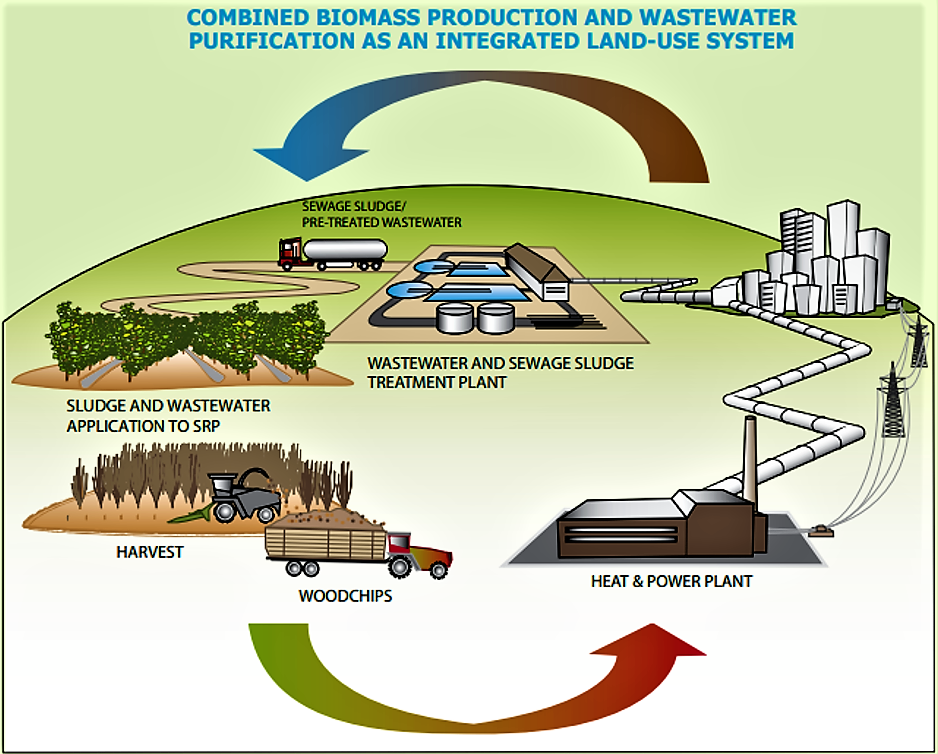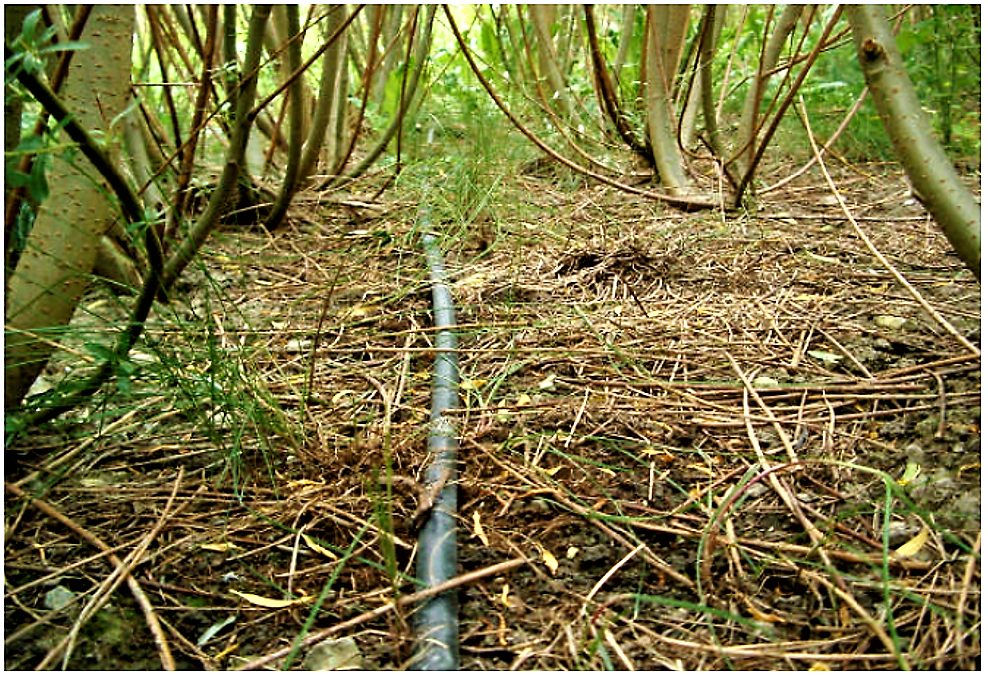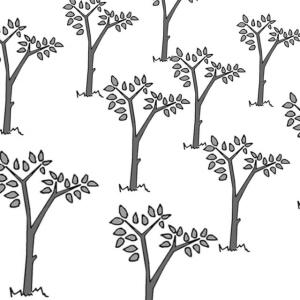Executive Summary
A short rotation plantation (SRP) is an integrated agro forestry land-use system combining biomass production with wastewater use and purification. Fast growing tree species are managed in short coppicing cycles. These non-food/non-fodder crops have a high demand for nutrients and water, which may alternatively be met by reusing pre-treated wastewater and sewage sludge, enabling a sustainable nutrient recycling. The woody biomass produced can be used as a renewable and clean fuel for heat and power generation, or for further processing into liquid biofuels.
| In | Out |
|---|---|
Energy Crops |
Basic Information
The reuse of pre-treated domestic wastewater or sewage sludge for irrigation and fertilisation of energy crops in short rotation plantations is a new approach, which aims at using the nutrients contained in waste residues for an enhanced biomass growth.

The name short rotation plantation (SRP) is used, since usually fast growing tree species such as willows and poplars are planted, which are harvested after relatively short periods. The harvesting periods usually take between 2 to 8 years, but in the case of herbaceous plants or grasses it can be also annually (SUSANA 2009). The cultivation intensity, the high nutrient uptake and the frequent harvests require constant irrigation and fertilisation. By irrigating with (pre-treated) nutrient-rich wastewater, fertiliser costs are reduced, plant growth is enhanced, and waste products are subjected to a more sustainable treatment.

While constructed wetlands focus mainly on wastewater treatment and are sealed at their base for groundwater protection, the advantage of SRPs over constructed wetlands lies in the combined wastewater treatment and the production of wooden biomass, which means an additional income for farmers. A SRP represents an open-bottom fixed-bed reactor of a construction height of between 1.0 and 1.5 m resulting in an effective reduction of pathogens (SUSANA 2009).
In order to avoid nutrient overload, the wastewater application has to follow a dosing recommendation depending on the site and plant species. In addition, the nitrate content has to be measured by soil samples or by sampling from drainage channels.
The following substrates can be applied on SRPs
- Domestic wastewater (which contains nutrients in ratios that are close to the nutrient needs of short-rotation-plantations),
- Sewage sludge originating from domestic wastewater,
- Industrial wastewater from food processing or beverage industries, and
- Diverted human urine
Wastewater is usually applied on SRPs by means of surface irrigation in order to avoid aerosol formation and spread of pathogens by air.
Besides the above-mentioned benefits, there are also a number of critical points to consider:
- Groundwater pollution (from nitrate, pathogens and toxic substances especially if industrial wastewater is applied) might occur and needs to be prevented
- The increase in soil salinity resulting from the irrigation with wastewater (containing salts like e.g. sodium chloride and hydrocarbonates) might become a problem
To ensure environmental and hygienic safety, wastewater and sewage sludge must be pre-treated before being used in SRPs.
In the EU the agricultural application is regulated through the Nitrates Directive (91/676/EEC), Sewage Sludge Directive (86/278/EEC), and other national specifications defining maximum application loads for nutrients and chemical pollutants.
Pre-treatment further reduces pathogenic risks and allows compliance with local legislation for soil and water quality.
Developing countries often suffer from a lack of available energy resources. Electricity, fuel or firewood are scarce resources. Here SRPs can provide an efficient and renewable source of energy. The implementation of such technology, particularly on larger scale, can furthermore create income and job opportunities for many people at a local level.
It has to be considered that a huge amount of untreated domestic sewage is required to fertilise the renewable biomass. By using sewage to fertilise and improve the soils this technology is also possible in areas with marginal and poor soils that are lacking nutrients and minerals. However the agricultural production site has to be appropriate for fast growing tree species — they should not compete with areas that can be used for agricultural food production.
In addition the risk of groundwater and surface water pollution can be reduced considerably through the application of partly treated wastewater and sludge to the wooden biomass.
Short Rotation Plantations: Opportunities for Efficient Biomass Production with the Safe Application of Wastewater and Sewage Sludge
This two-page factsheet by the European Biomass Industry Association gives a brief and concise overview on the topic of Short Rotation Plantations. Especially the benefits of this technology are highlighted.
EUBIA (2008): Short Rotation Plantations: Opportunities for Efficient Biomass Production with the Safe Application of Wastewater and Sewage Sludge. Brussels: European Biomass Industry Association (EUBIA) URL [Accessed: 26.05.2019]Links between Sanitation, Climate Change and Renewable Energies
This factsheet of Sustainable Sanitation Alliance describes the impact of greenhouse gases on climate change and focuses on the advantages of renewable energies. Therefore many different technologies like production of biogas or short-rotation-plantations are mentioned.
SUSANA (2009): Links between Sanitation, Climate Change and Renewable Energies. Eschborn. (= SuSanA fact sheet 09/2009 ). Sustainable Sanitation Alliance (SuSanA) URL [Accessed: 26.05.2019]Short-rotation Willow Biomass Plantations Irrigated and Fertilised with Wastewaters
This report summarises results and experiences gathered from field trials with recycling of pre-treated wastewater, diverted human urine mixed with water, and municipal sludge, within plantations of willow species specifically selected for biomass production. Experimental sites were established in Sweden (Roma), France (Orchies), Northern Ireland (Culmore) and Greece (Larissa). The project “Biomass Short-Rotation Willow Coppice Irrigated and Fertilised with Municipal Wastewater” was carried out during a four-year period with financial support from the EU FAIR Programme.
LARSSON, S. WEIBULL, S. CUIGNET, C. CLAUSE, P. JACOBSSON, I. ARONSSON, P. PERTTU, K. ROSENQUIST, H. DAWSON, M. WILSON, F. BACKLUND, A. MAVROGIANOPOULUS, G. RIDDEL-BLACK, D. CARLANDER, A. STENSTROEM, T. A. HASSELGREN, K. (2003): Short-rotation Willow Biomass Plantations Irrigated and Fertilised with Wastewaters. (= Sustainable Urban Renewal and Wastewater Treatment , 37 ). Denmark: Danish Environmental Protection Agency, Danish Ministry of the Environment URL [Accessed: 04.08.2010]Performance and Sustainability of Short-Rotation Energy Crops Treated with Municipal and Industrial Residues
The summary of this doctoral thesis by Ioannis Dimitriou analyses the performance and sustainability of short rotation plantations treated with municipal and industrial wastes and contains the results of several scientific papers.
DIMITRIOU, I. (2005): Performance and Sustainability of Short-Rotation Energy Crops Treated with Municipal and Industrial Residues. (= Doctoral Thesis ). Uppsala: Swedish University of Agricultural Sciences URL [Accessed: 09.08.2010]Short Rotation Plantations: Opportunities for Efficient Biomass Production with the Safe Application of Wastewater and Sewage Sludge
This two-page factsheet by the European Biomass Industry Association gives a brief and concise overview on the topic of Short Rotation Plantations. Especially the benefits of this technology are highlighted.
EUBIA (2008): Short Rotation Plantations: Opportunities for Efficient Biomass Production with the Safe Application of Wastewater and Sewage Sludge. Brussels: European Biomass Industry Association (EUBIA) URL [Accessed: 26.05.2019]Full-scale implementation of short rotation willow coppice, SRC, in Sweden
This paper contains information on short rotation plantations in Sweden. Beside the description of harvesting willow, they summarize historical facts and present information on willow varieties, policies and the way of using sewage for fertilizing.
LARSSON, S. LINDEGAARD, K. (2003): Full-scale implementation of short rotation willow coppice, SRC, in Sweden. Orebro: Agrobraensle (AB). [Accessed: 04.08.2010] PDFShort-rotation Willow Biomass Plantations Irrigated and Fertilised with Wastewaters
This report summarises results and experiences gathered from field trials with recycling of pre-treated wastewater, diverted human urine mixed with water, and municipal sludge, within plantations of willow species specifically selected for biomass production. Experimental sites were established in Sweden (Roma), France (Orchies), Northern Ireland (Culmore) and Greece (Larissa). The project “Biomass Short-Rotation Willow Coppice Irrigated and Fertilised with Municipal Wastewater” was carried out during a four-year period with financial support from the EU FAIR Programme.
LARSSON, S. WEIBULL, S. CUIGNET, C. CLAUSE, P. JACOBSSON, I. ARONSSON, P. PERTTU, K. ROSENQUIST, H. DAWSON, M. WILSON, F. BACKLUND, A. MAVROGIANOPOULUS, G. RIDDEL-BLACK, D. CARLANDER, A. STENSTROEM, T. A. HASSELGREN, K. (2003): Short-rotation Willow Biomass Plantations Irrigated and Fertilised with Wastewaters. (= Sustainable Urban Renewal and Wastewater Treatment , 37 ). Denmark: Danish Environmental Protection Agency, Danish Ministry of the Environment URL [Accessed: 04.08.2010]Short Rotation Coppice (SRC) Production in Italy
Short Rotation Crops in the World: IEA-Bioenergy Task 30 Organization and Priorities
This paper focuses on improving production system efficiencies and reducing negative environmental impacts from short rotation crop systems and applying short rotation crops systems for specific environmental purposes. Topics such as identifying co-product opportunities that could facilitate short rotation crops uptake, accelerating deployment of short rotation crops systems and identification of barriers to large-scale implementation are also included.
VERWIJST, T. (2004): Short Rotation Crops in the World: IEA-Bioenergy Task 30 Organization and Priorities. In: Biomassa & Energia: Volume 1 , 113-121.IEA-Bioenergy Task 30 Short Rotation Crops for Bio-energy Systems
This is the corresponding presentation to the paper‚ Short Rotation Crops in the World’ of Theo Verwijst.
VERWIJST, T. (2004): IEA-Bioenergy Task 30 Short Rotation Crops for Bio-energy Systems. Sweden: Swedish University of Agricultural Sciences, Department of Crop Production, Ecology Section of Short Rotation ForestryRecycling of wastewater and sludge in Salix Plantations. Sustainable and profitable use of waste resources and farmland in Europe for production of biofuels
An eight-page factsheet on the reuse of wastewater and sludge in willow plantations, also presenting some case sties from Europe.
AGROBRAENSLE ; SWEDISH ENERGY AGENCY ; SWEDISH UNIVERSITY OF AGRICULTURAL SCIENCES ; SWECO VIAK (2000): Recycling of wastewater and sludge in Salix Plantations. Sustainable and profitable use of waste resources and farmland in Europe for production of biofuels. URL [Accessed: 09.08.2010]Potential of short rotation woody energy crops for solid biofuel production in Latvia
This one-page poster/factsheet provides core information on a doctoral study at the Latvia University of Agriculture on the potential of short rotation energy crop production in Latvia, which has been conducted between 2005-2008 and gives useful links to further information.
LAZDINA, D. LIEPA, I. (2009): Potential of short rotation woody energy crops for solid biofuel production in Latvia. Salaspils, Latvia: Latvia State Forest Research Institute “Silava”, Latvia University of Agriculture Forest FacultyLinks between Sanitation, Climate Change and Renewable Energies
This factsheet of Sustainable Sanitation Alliance describes the impact of greenhouse gases on climate change and focuses on the advantages of renewable energies. Therefore many different technologies like production of biogas or short-rotation-plantations are mentioned.
SUSANA (2009): Links between Sanitation, Climate Change and Renewable Energies. Eschborn. (= SuSanA fact sheet 09/2009 ). Sustainable Sanitation Alliance (SuSanA) URL [Accessed: 26.05.2019]
